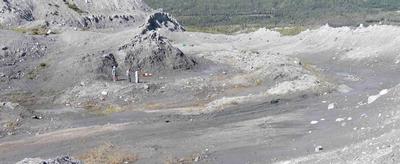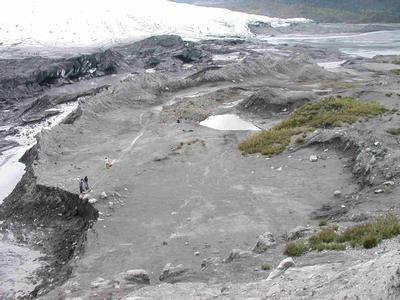26 July, 2001
Quiet at camp, Data Processing and more GPR
10:00 p.m.
This afternoon, the morning clouds were burnt away by the sun and the rest of
the afternoon has been spectacular and sunny. The wind, which was blowing
quite strongly for much of the afternoon has died down. A first-quarter moon
is overhead as the sun sinks behind the mountains in the west (or rather, as
the Earth spins, the mountains block our view of the sun)
Life on ice ... almost
Most of the REU students went to town today for laundry and shopping and
didn't return until after dinner. The CRREL guys were also gone for much of
the day. So when Kendra, Justin, Greg and I returned form collecting data
this afternoon, we had the camp to ourselves.
I made (what I thought would be) a quick stop by my tent to change my socks.
I laid down to make the process a little easier and forgot to get up... Sleep
crept in; the 45-minute nap in the sun-warmed tent was perfect.
At dinner, Greg shared more of his huge repetoire of very funny jokes
(unfortunately, most are not appropriate to share in this forum). We were
all laughing like crazy.
Science at work
I spent the morning processing more of the seismic data that we collected
last week.
I mentioned yesterday that data collection (and lots of it!) is an absolutely
necessary
part of science, however plain or even tedious (boring after lots of
repititions) it may be. Data processing is another necessary step.
In this morning's work, we graphed over 5,000 points of data to precisely
calculate the velocity of the seismic wave through the Earth (remember, the
velocity measurements are the key to being able to compare the seismic data
and the radar data... see July 24 journal). I've included our graph below.
The velocity of seismic waves in ice: 3823.4 meters per second, over 10
times faster than the speed of sound in air.
This afternoon, we collected more data at Justin's points... It was a nice
day to be out, and the people with whom I get to work are super cool.
Anyhow, I have an early start tomorrow (WebCast at 6:30 a.m. Alaska time...
catch it if you can!!) and need to collect more sleeping pattern data.
Cheers.
~SM

Over 5,000 points of data give us a very good idea about the speed at which the seismic waves are traveling through ice: 3,823 m/s

This is the view from the south end of site looking north. It got a bit mucky in places.

This is the view from the hill at the north end of the site where we collected Justin's data.

We collected data for a long time, but in a place like this, you'd be crazy not to enjoy it. What a spectacular place!
Contact the TEA in the field at
.
If you cannot connect through your browser, copy the
TEA's e-mail address in the "To:" line of
your favorite e-mail package.
|
